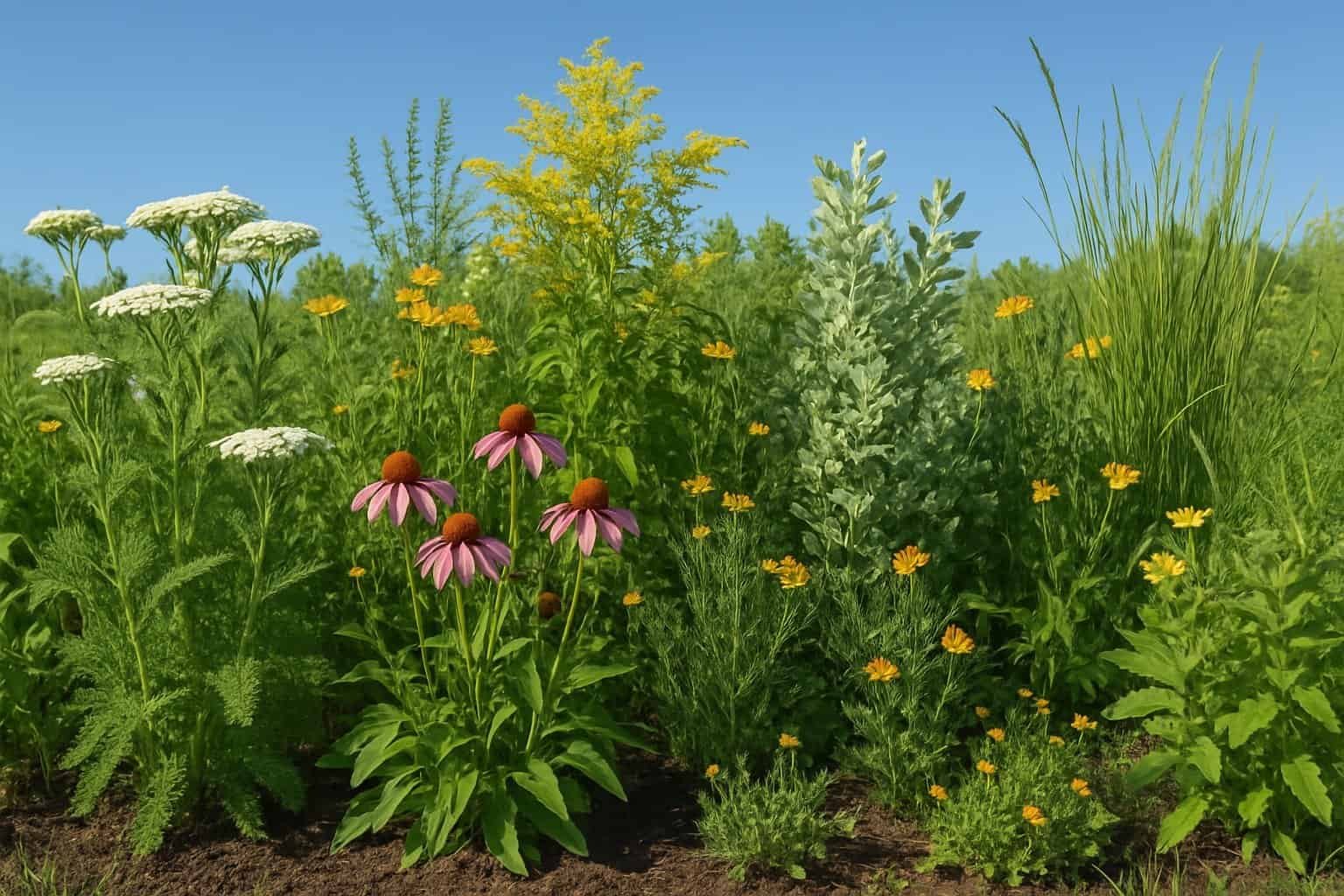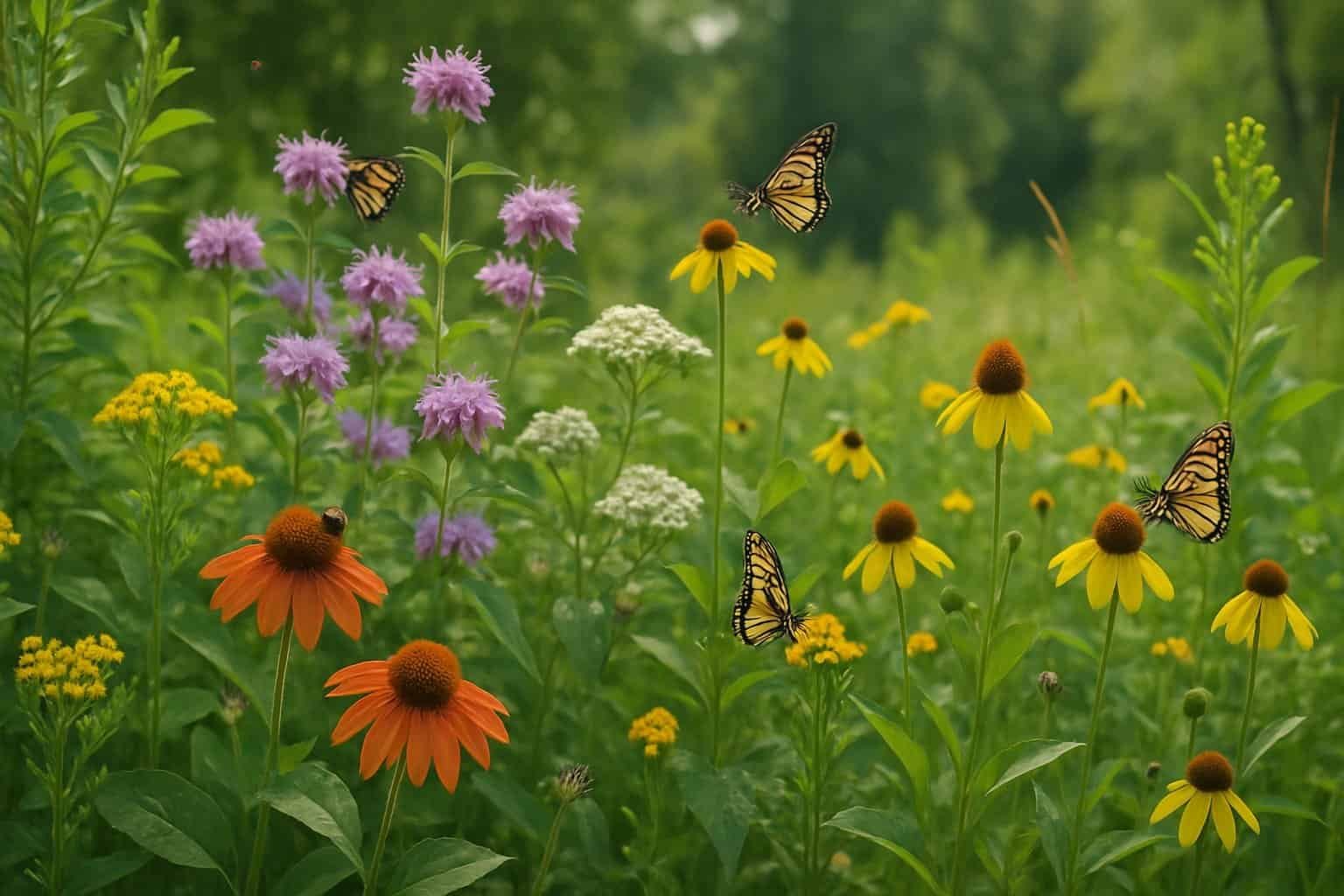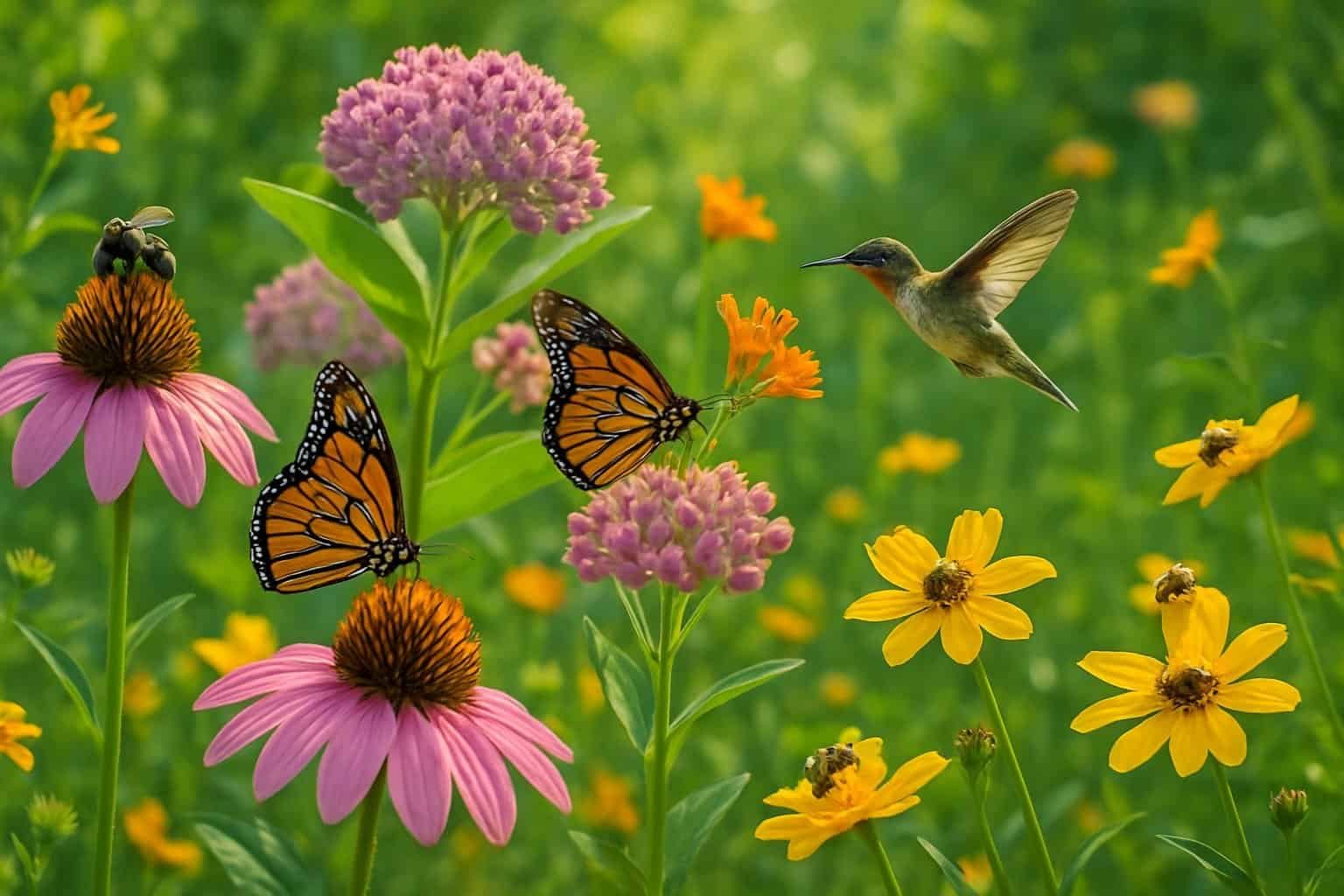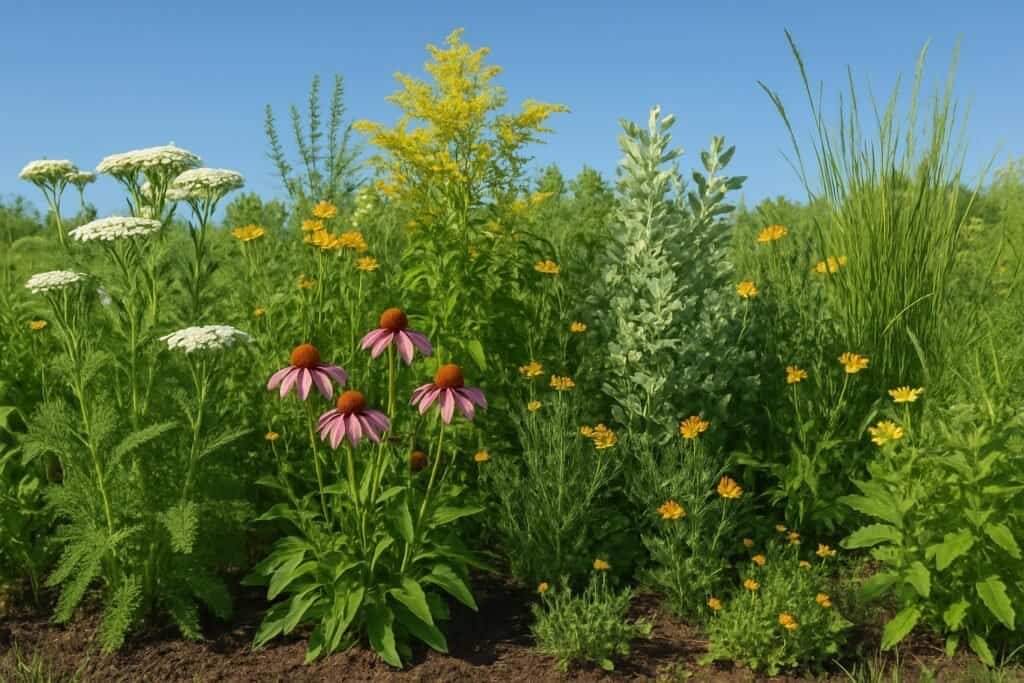Plants surround us, but not all plants support local ecosystems equally. Native plants are species that occur naturally in a specific region and have evolved over thousands of years alongside local wildlife, climate conditions, and soil types.
Unlike introduced or exotic species, native plants have deep relationships with their environment.

These local plants play crucial roles in maintaining healthy ecosystems. They provide food and shelter for native insects, birds, and other wildlife that depend on them.
Native plants usually need less water, fertilizer, and maintenance than non-native plants. They thrive because they’re adapted to local conditions.
Key Takeaways
- Native plants naturally occur in a specific region and have evolved alongside local wildlife and environmental conditions.
- They support local ecosystems by providing essential habitat and food for wildlife while requiring less maintenance and resources.
- Using native plants in gardens and landscapes helps conserve biodiversity and creates sustainable, regionally appropriate outdoor spaces.
Defining Native Plants
Native plants have evolved in a specific geographic area over thousands of years and exist there naturally without human introduction. These plants develop important relationships with local wildlife, soil microbes, and other elements of their ecosystem.
Characteristics of Native Species
Native plants adapt specifically to local conditions through natural selection. They usually need less water, fertilizer, and pest control than non-native species once established.
Their root systems fit local soil types and often grow deeper than those of non-natives. Native species follow natural growth cycles aligned with regional seasons.
They provide food and habitat for local wildlife, including pollinators, birds, and mammals. Native plants contribute to biodiversity by supporting many life forms.
Research shows that native oak trees can support over 500 species of caterpillars. Non-native alternatives often support fewer than 10 species.
Distinction from Non-Native and Invasive Plants
Non-native plants come from different regions or continents and arrive through human introduction. These plants did not evolve with local ecosystems and may not offer the same ecological benefits.
Invasive plants are a subset of non-native species that spread aggressively and cause harm. They displace native plants by outcompeting them for sunlight, water, and nutrients.
Common invasive species include kudzu, purple loosestrife, and Japanese knotweed. Not all non-native plants become invasive, and many remain well-behaved in gardens.
However, invasive plants can escape cultivation and cause significant ecological and economic damage by reducing biodiversity and changing natural habitats.
Ecological Importance of Native Plants

Native plants support local ecosystems and wildlife. They form the foundation of healthy environments and help maintain nature’s balance.
Role in Biodiversity
Native plants create the backbone of biodiversity in any region. They evolve alongside other local species for thousands of years, forming complex relationships that maintain ecosystem health.
When native plant populations decline, the effect ripples through the entire ecosystem. Areas with abundant native plants host 3-4 times more insect and bird species than areas dominated by non-natives.
Native plants contain genetic diversity that helps them adapt to changing conditions. This adaptation helps ecosystems stay resilient during environmental changes like drought or flooding.
Many endangered species depend on native plants for survival. For example, monarch butterflies require milkweed to complete their life cycle.
Supporting Ecosystems and Habitats
Native plants create structure and shelter for wildlife habitats. Their growth patterns, height, and density provide the physical environment where animals live.
These plants help maintain healthy soil conditions. Their root systems prevent erosion and often reach deeper than non-natives, which improves soil structure and water filtration.
Native plants usually need less water once established. They have adapted to local rainfall patterns and can withstand regional weather extremes better than imported species.
Many native plants form partnerships with soil fungi and bacteria. These relationships improve nutrient cycling and soil health throughout the ecosystem.
Food Sources for Wildlife
Native plants provide essential food for wildlife at every level of the food chain. They produce nectar, pollen, seeds, fruits, and leaves that match the nutritional needs of local animals.
Birds rely heavily on native plants for food. A single chickadee family needs 6,000-9,000 caterpillars to raise one brood, and these caterpillars depend on native plants.
Native plants produce fruits and seeds that ripen at times that align with wildlife needs. This timing is crucial for migrating species.
Even dead native plants support wildlife. Decomposing plant material feeds many organisms and returns nutrients to the soil.
Native Plants and Pollinators

Native plants and their pollinators have evolved together, creating strong partnerships. These relationships benefit both the plants and the creatures that help them reproduce.
Pollinator Attraction
Native plants have features that attract local pollinators. Flower shapes, colors, and scents evolved to appeal to certain insects and birds.
Tubular flowers often attract hummingbirds with bright red or orange colors. Bees prefer blue, purple, and yellow blooms with landing platforms.
Butterflies are drawn to red and purple flowers with flat tops. Moths visit white or pale flowers that release strong scents at night.
Native plants often produce more nectar and pollen than non-native plants. This makes them excellent food sources for local pollinators.
A single native oak tree can support over 500 species of caterpillars. Non-native alternatives might support few or none.
Bloom Time and Seasonal Support
Native plant communities provide food throughout the growing season. Different species bloom at different times, creating a continuous supply of nectar and pollen.
Spring bloomers like redbud, dogwood, and wild geranium offer food when pollinators first emerge. Summer flowering plants such as coneflower, bee balm, and black-eyed Susan provide resources during peak activity.
Fall blooming species like goldenrod and asters supply nutrition before winter. This timing is crucial for migrating species like monarch butterflies.
A garden with varied bloom times ensures pollinators have food from early spring through late fall.
Benefits of Landscaping with Native Plants
Using native plants in your garden brings many advantages. They thrive in local conditions while saving time, money, and resources.
They also help protect wildlife and create beautiful landscapes.
Resilience to Local Climate
Native plants have adapted to local weather patterns over thousands of years. This makes them naturally resistant to temperature extremes, rainfall changes, and soil conditions.
During droughts, established native plants often survive without extra watering. Their deep root systems help them find moisture deep in the soil.
These roots also protect against flooding by absorbing excess water. Native plants have built natural defenses against local pests and diseases.
They rarely need chemical treatments to stay healthy. Many can withstand seasonal challenges like frost, heat waves, or high winds that might kill non-native species.
Easier to Grow and Maintain
Native plants require less work than exotic varieties. Once established, they typically need:
- Less watering
- Minimal or no fertilizer
- Fewer pesticides
- Less pruning and maintenance
These plants grow well in your area’s soil, so they rarely need soil amendments. Their natural growth patterns don’t require constant shaping.
Native plants form balanced relationships with local insects and microorganisms. This creates a self-sustaining mini-ecosystem in your yard.
For busy homeowners, this means more time enjoying your garden and less time working in it. Reduced maintenance also makes native landscaping more affordable over time.
Conservation and Beauty
Native plant gardens support local wildlife in crucial ways. They provide:
- Food sources for pollinators like bees, butterflies, and hummingbirds
- Shelter and nesting sites for birds and beneficial insects
- Host plants where butterflies and moths lay eggs
This habitat creation helps preserve biodiversity in your community. As development removes natural areas, home gardens with native plants become important wildlife corridors.
Native landscapes connect us to regional identity and natural heritage. Each area’s native plants create distinctive garden styles that reflect local character.
Native gardens can be stunning. They offer seasonal interest with unique flowers, berries, fall colors, and textures.
Many native plants have been developed into cultivars with ornamental qualities while keeping their ecological benefits.
Native Plants in Garden Design
Native plants transform gardens into vibrant ecosystems that support local wildlife while reducing maintenance needs. They connect our spaces to the natural world and help preserve biodiversity in our communities.
Creating Native Gardens
Designing with native plants starts with understanding your local ecosystem. Research which plants naturally grow in your region before making selections.
Native plants usually need less water, fertilizer, and pesticides than non-native species once established. Group plants with similar needs together to create efficient planting zones.
Consider bloom times to ensure year-round visual interest and continuous food sources for pollinators.
A well-designed native garden includes different layers:
- Canopy: Native trees for shade and structure
- Middle layer: Shrubs and small trees
- Herbaceous layer: Wildflowers, grasses, and groundcovers
Include paths and seating areas to enjoy your native garden up close. Even small spaces can include native plant communities that attract butterflies, birds, and beneficial insects.
Role of Deep Root Systems
Native plants often develop extensive root systems that benefit gardens and landscapes. These roots can reach depths of 15 feet or more, compared to the shallow roots of many non-native ornamentals.
Deep roots improve soil structure by creating channels for water to penetrate. This reduces runoff and erosion during heavy rains.
The underground network also captures and filters water, helping to recharge groundwater supplies. Native plant roots add organic matter to soil as they grow and die back.
This builds soil health over time without extra amendments. During droughts, deep-rooted natives can access moisture unavailable to shallow-rooted plants.
This drought tolerance means less supplemental watering is needed, saving time and resources in garden maintenance.
Enhancing Natural Areas
Native plants connect gardens to surrounding natural landscapes. They create wildlife corridors that allow animals to move safely between habitats.
Consider these approaches when enhancing natural areas:
- Remove invasive species that compete with natives.
- Plant buffer zones of natives around sensitive areas.
- Include water features with native aquatic plants.
Native plant communities support complex food webs. A single oak tree can host hundreds of insect species, which feed birds and other wildlife.
Allow some areas to develop their natural cycles. Fallen leaves provide habitat for beneficial insects and return nutrients to the soil.
Dead flower heads offer winter food sources for birds.
Selecting and Sourcing Native Plants
Finding the right native plants for your garden requires knowing where to look and what to look for. The right resources can help you identify which plants naturally grow in your region and where to purchase them.
Using Native Plant Finders
Native plant finders are online tools that help identify plants suited for specific regions. The National Wildlife Federation’s Native Plant Finder lets users search by zip code to discover plants that support local wildlife.
The Audubon Society offers a similar database focused on plants that benefit bird populations. Enter your location to see a customized list of native plants.
Many state extension offices and botanical gardens have created regional native plant guides. These resources often include information about soil preferences, sun requirements, water needs, wildlife benefits, and seasonal interest.
Native plant finders categorize plants by type, such as trees, shrubs, or grasses. They also match plants to your garden’s specific environment based on growing conditions.
Locating Native Plant Nurseries
Specialized native plant nurseries offer the best selection of local plant species. These nurseries focus on plants adapted to regional conditions, unlike big box stores.
To find native plant nurseries near you, check with local native plant societies, conservation organizations, Master Gardener programs, and botanical gardens.
Many areas host native plant sales in spring and fall. These events often feature plants grown by conservation groups and local enthusiasts.
Online native plant nurseries expand options for gardeners in areas with limited local resources. When ordering, confirm the plants’ origins to ensure they’re native to your region.
Ask nursery staff about the source of their plants. Nursery-propagated natives are preferable to those harvested from the wild, which can harm natural populations.
Native Cultivars and Nativars
When exploring native plants, you’ll encounter modified versions bred for specific traits. These plant varieties raise questions about their role in native landscaping and ecological function.
Understanding Cultivars and Nativars
A cultivar is a plant variety selected and maintained through cultivation. Cultivars have specific traits like flower color, size, or disease resistance.
Growers typically propagate these plants through cuttings or grafting to keep their distinct characteristics. Native cultivars, often called “nativars,” are cultivated varieties of native plant species.
Breeders select nativars from natural variations found in wild populations or develop them through breeding programs. You can identify nativars by their naming convention, which usually includes the species name followed by a cultivar name in quotes, such as Echinacea purpurea ‘Magnus’.
Nativars offer practical benefits for gardeners, including more predictable growth habits, enhanced ornamental features, greater disease resistance, and better adaptability to garden conditions.
Differences in Performance and Ecological Value
Nativars often perform differently from their wild counterparts in ecological settings. Research shows they may provide fewer benefits to wildlife.
Ecological considerations:
- Pollinators may visit some nativars less frequently.
- Modified flower structures can limit nectar or pollen access.
- Altered leaf chemistry might reduce insect feeding.
- Some nativars produce less seed for birds and wildlife.
Performance varies widely. Some nativars retain significant ecological value, while others show reduced functionality.
For example, studies of Echinacea cultivars found that simple color changes had minimal impact on pollinator visits. Heavily modified flower forms attracted fewer insects.
When selecting plants, consider the degree of modification. Slightly different leaf color may have little ecological impact, while plants with drastically altered growth habits might function differently in the landscape.
Notable Examples of Native Plants
Native plants come in many varieties across North America. Each offers unique characteristics and benefits for local ecosystems.
These plants have adapted to local conditions over thousands of years. They provide essential habitat for wildlife.
Coneflower
Coneflower (Echinacea) is a popular native perennial with a distinctive dome-shaped center and colorful petals. Most species display purple flowers, but varieties also come in white, yellow, and orange.
This hardy plant thrives in USDA zones 3-9 and prefers full sun with well-drained soil. Coneflowers bloom from June through August and reach heights of 2-4 feet.
Benefits of Coneflowers:
- Attracts pollinators like bees and butterflies.
- Drought-resistant once established.
- Provides winter food for birds (seeds).
- Medicinal properties (used in herbal supplements).
Coneflowers require minimal maintenance and resist most pests and diseases. They spread gradually through self-seeding and can be divided every 3-4 years to maintain vigor.
Monarda
Monarda, commonly called bee balm or wild bergamot, is a fragrant native perennial in the mint family. Its showy flower clusters appear in red, pink, purple, or white atop stems reaching 2-4 feet tall.
This plant grows best in zones 4-9 with partial to full sun. It prefers moist, rich soil but adapts to various conditions.
The unique tubular flowers bloom from mid-summer to early fall.
Bee balm offers several advantages:
- Attracts hummingbirds, butterflies, and bees.
- Aromatic leaves can be used for tea.
- Deer and rabbit resistant.
- Traditional medicinal uses by Native Americans.
Monarda can spread aggressively through underground rhizomes. Regular division every 2-3 years helps control its growth and prevents powdery mildew issues in humid areas.
Blue Flag Iris
Blue Flag Iris (Iris versicolor) is a stunning native wetland plant with violet-blue flowers marked by yellow and white. This elegant perennial grows 2-3 feet tall in clumps with sword-shaped leaves.
It thrives in zones 3-9 in consistently moist or wet soils. Blue Flag Iris prefers wet feet and grows naturally along pond edges, in rain gardens, and in wetland areas.
Blue Flag Iris blooms in late spring to early summer. Each flower lasts only a few days, but the plant produces many blooms over several weeks.
Key characteristics:
- Ideal for water gardens and boggy areas.
- Provides habitat for frogs and aquatic insects.
- Low maintenance once established.
- Filters pollutants from water.
Do not consume the rhizomes, as they contain toxins that can cause digestive upset.
Challenges and Considerations
Growing native plants brings specific challenges. Gardeners and conservationists must adapt to changing climate conditions and manage aggressive non-native species that threaten local ecosystems.
Impact of Climate Change on Native Species
Climate change is altering growing conditions for native plants in many regions. Rising temperatures shift growing zones northward, affecting when plants flower, set seed, and go dormant.
Some native species struggle to adapt quickly enough to these changes. Plants that evolved in specific temperature ranges may face stress when those ranges shift.
Extreme weather events like droughts, floods, and unseasonable frosts threaten established native plant communities. These events can damage or kill plants that aren’t adapted to such conditions.
Gardeners can help by selecting native species that show resilience to changing conditions. Creating microhabitats with varied sun exposure and moisture levels provides refuge during climate stress.
Managing Invasive Species
Invasive plants often outcompete natives by growing faster, reproducing more efficiently, or lacking natural predators. They can quickly transform diverse ecosystems into monocultures with reduced wildlife value.
Early detection is crucial for effective management. Identifying and removing invasive species before they establish prevents larger problems later.
Various control methods exist, including manual removal, targeted herbicides, and biological controls. The best approach depends on the specific invasive species and site conditions.
Native plant restoration after invasive removal helps prevent reinvasion. Dense plantings of appropriate natives can create communities resistant to future invasions.
Community education programs help spread awareness about invasive species identification and proper disposal techniques. Many invasive plants began as garden escapees.
Frequently Asked Questions
Native plants raise many questions for gardeners and ecology enthusiasts. The following answers address common inquiries about identification, benefits, and practical applications of native plants.
How are plants classified as native?
Plants are classified as native when they occur naturally in a region without human introduction. They have evolved in that area over thousands of years, adapting to local soil, climate, and wildlife.
Scientists determine native status by studying historical records, fossil evidence, and plant distribution patterns. A plant is generally considered native if it existed in a region before European colonization.
Geographic boundaries like mountain ranges, rivers, and deserts often define native plant regions. These natural barriers created distinct plant communities with unique adaptations.
Why should one consider planting native species in their garden?
Native plants require less maintenance once established because they’ve adapted to local conditions. They typically need less water, fertilizer, and pest control than non-native alternatives.
These plants support local wildlife by providing appropriate food and habitat. Birds, butterflies, and beneficial insects rely on native plants they’ve evolved alongside.
Native gardens help preserve biodiversity and regional identity. As development removes natural areas, home gardens with native plants become increasingly important wildlife refuges.
What distinguishes native plants from non-native varieties?
Native plants evolved in their local ecosystems over thousands of years. Non-native plants were introduced from other regions, either accidentally or deliberately for ornamental purposes.
Adaptation to local conditions marks a key difference. Native plants typically handle regional weather extremes, soil conditions, and pest pressures better than introduced species.
Native plants form part of a complex ecological web with local wildlife. Non-native plants often don’t provide the same nutritional value or habitat benefits to local species.
Can you list common examples of native plants?
Eastern North America features natives like purple coneflower, black-eyed Susan, and cardinal flower. These wildflowers support pollinators and add vibrant colors to gardens.
Western states claim manzanita, California poppy, and various sagebrush species as natives. These drought-tolerant plants thrive in arid conditions while supporting local wildlife.
Trees like oak, maple, and pine have native species across different regions. These long-lived plants form the backbone of many ecosystems and support hundreds of wildlife species.
What ecological benefits do native plants offer?
Native plants conserve water by requiring less irrigation once established. Their deep root systems help prevent erosion and improve soil structure.
They support pollinators essential for food production. Bees, butterflies, and birds rely on native plants for nectar, pollen, seeds, and nesting materials.
Native plant communities filter water runoff and help recharge groundwater supplies. Their presence improves soil health and can reduce pollution in waterways.
How can I identify native plants that are suitable for my local area?
Local extension offices provide information about native plants in your region. They often offer planting guides for specific counties.
Native plant societies maintain databases of local species. Their members share advice about what grows best in your area.
Public gardens and arboretums display native plants in demonstration gardens. Visiting these places helps you see mature plants and understand their growth before planting.



